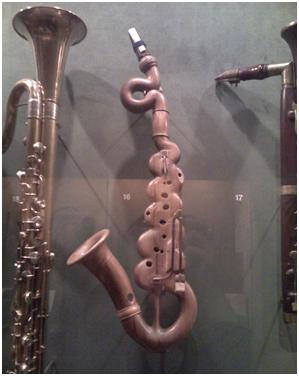Watching the Inauguration on TV today, this former chamber musician and band geek had to give a shout out for the John Williams piece performed by cellist Yo-Yo Ma, violinist Itzhak Perlman, pianist Gabriela Montero and clarinetist Anthony McGill. I performed in chamber groups on both flute and piano during my high school piano recitals. Beethoven’s clarinet trio (I was on piano) remains a highlight.
Clarinets came to my mind again last Friday as I wandered through the Metropolitan Museum of Art with a friend. I’d never explored the collection of musical instruments before, and I snapped a photo of this unusual clarinet with my camera phone.

This bass clarinet was made by Nicola Papalini in the early 19th century. The curvy design helped them scrunch the spacing that was needed between the keys for the low register of this instrument. Papalini carved the instrument in halves and then assembled the finished instrument. It’s a pretty nifty art object, but I’d love to hear it played.
Clarinet acoustics are based on a closed pipe—the reed and mouthpiece on one end mean that the sound waves encounter that end of the pipe as effectively closed off compared to my favorite woodwind, the flute. That structure effectively doubles the length of the bore, which allows the clarinet to achieve those rich low tones.
Just like the chamber music, I hope that the history made today will permeate, rebound and echo in the days, weeks and years to come.

As it turns out, the Inauguration performance was a clever charade of playing along to a previous recording. I completely understand why they did it: http://www.nytimes.com/2009/01/23/arts/music/23band.html. At the time I wondered why they all needed earpieces, but didn’t question it. Now I know.
While I was watching the performance I wondered how on earth they were keeping their instruments tuned in that temp. But, despite being recorded, it was played beautifully.